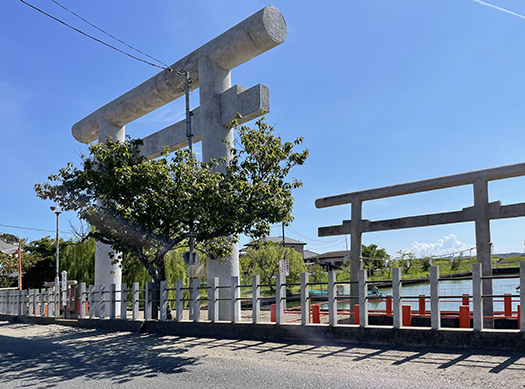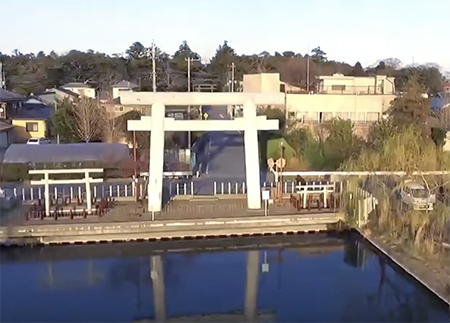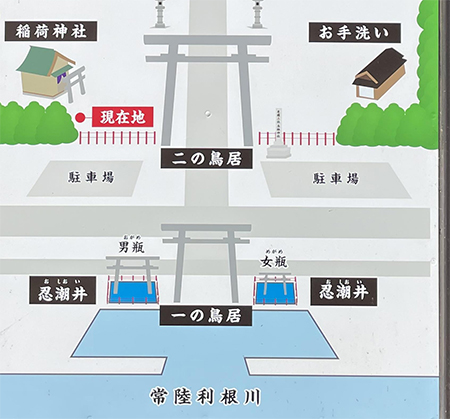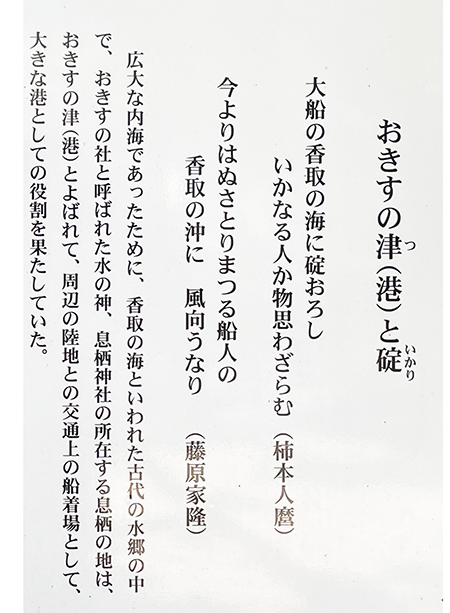


鹿島や香取は海との関係はそれなりには感じるけれど、この息栖に至ってなぜ、東国三社というように言われ続けてきたのかのワケが腑に落ちてきています。
そもそもこの日本列島に現生人類が到達したのには海を渡って来たのでしょう。わたしたち日本人のルーツにはそういうDNAが深く宿っているのだと思う。「大工」という人間の仕事の最初期とは家や建築物を作ることではなく、船をつくることが本然の仕事、スタートだったとされる。船大工というのが始原に近く、家大工はそこから派生してきた存在なのだと言われる。
そして石器時代の昔からこうした船大工を束ねて日本列島地域に現生人類のいろいろな系統が多数、波状的に移住してきたというのが実態なのでしょう。この列島地域で世界有数の豊富な漁業資源とめぐり会って、海辺で定住した。
魚という、陸上動物とはまったく違う行動原理を持った狩猟対象と本格的に出会い、縄文集落という定住生活が始まった。日本の神社文化には、こうした悠久の記憶遺産が反映している部分が強い。
こうした民族意識の底流の海民的伝統、それへの素朴な帰依のこころがこの息栖神社のたたずまいからは立ち上っていると思える。写真は「一の鳥居」周辺、そこに湧き出る清水を祀る「男瓶」「女瓶」の小さな鳥居たち。まことに「海民」のための神宿る地なのでしょう。
一方でアマテラス系のヤマト王権は「葦原の中つ国」という米作適地でのコメ生産を主導する文化体系をこの列島に持ち込んで、殖産興業と人口増加を実現させてきたように思っている。
そういう東アジア的農耕文化と、先述した海民文化とが、排他的ではなく「和の国」として平和共存を目指して日本社会は建国されてきた流れが強いのではと感じています。

こうした古代からの海民伝統の聖地として東国三社は尊崇されてきたのではないか。
上の写真は息栖神社境内に置かれた説明板。
「大船の香取の海に碇おろし、いかなる人か物思わざらむ<柿本人麻呂>」
「今よりはぬさとりまつる船人の、香取の沖に風向かうなり<藤原家隆>」という2句。
〜広大な内海であったために香取の海と言われた古代の水郷のなかで、「おきすの社」と呼ばれた水の神、息栖神社のある息栖の地は「おきすの津(港)」と呼ばれていた。<中略>〜
600-700年代の歌人の歌は、当時の古代地形とそのなかでの息栖神社のたたずまいを浪漫的に伝えてくれる。はるかな船旅の末にこの地に来訪した柿本人麻呂さんは、たぶん船主が風を読んでいる様子をみながら、その場の空気感を描写してくれている。また、ぬさ〜幣帛。ごへい〜をかざして船旅の安全を祈願している様子は、古代の交通をあきらかにしてくれる。ため息が出るようだ。・・・
<この歌は息栖神社境内に説明があり、当然この息栖神社前の「香取の海」を歌ったものとリードされましたが、飛鳥の柿本人麻呂たちが謳ったのは近江の「香取海」という説もあることを注記します。>
English version⬇
Far-flung exchanges between the archipelago’s sea people and the breath shrine (2) Exploration of the three shrines in the eastern part of Japan – 22
Asuka poets convey the atmosphere of breath to the present day. The simple nature worship of the sea people, who prayed for the safety of ancient traffic. The shrine is a place of
While Kashima and Katori have a certain relationship with the sea, the reason why they have been referred to as the “Three Shrines of the East” is becoming clear to me now.
It is likely that the present-day humans arrived in the Japanese archipelago by crossing the sea. I believe that the roots of the Japanese people are deeply imbued with this kind of DNA. It is said that the earliest work of a “carpenter” was not to build houses or buildings, but to build ships. It is said that ship carpentry was close to the origin of carpentry, and house carpentry was derived from it.
The reality of the situation is that many different lineages of present-day humans migrated to the Japanese archipelago region in waves, uniting these ship carpenters since the Stone Age. In this archipelago region, they encountered one of the world’s richest fishery resources and settled down by the sea.
They encountered in earnest fish, a hunting target with behavioral principles completely different from those of land animals, and began a settled lifestyle known as the Jomon settlement. The culture of Japanese shrines reflects the legacy of this long-standing memory.
The simple devotion to the traditions of the seafaring people, which are at the bottom of our national consciousness, can be seen in the appearance of the shrine. The photo shows the area around the Ichino-torii (first torii), and the small torii (male and female) that enshrine the fresh water that gushes out of the torii. It is truly a place where the gods dwell for the “sea people.
Of course, I believe that the Yamato kingdom of Amaterasu lineage brought to this archipelago a cultural system that led rice production in the “reed field of Nakatsukuni,” a land suitable for rice cultivation, and realized reproduction, development, and population growth.
I feel that there is a strong trend toward a peaceful coexistence of such East Asian agricultural culture and the aforementioned seafaring culture as a “country of harmony” rather than exclusivity.
I believe that the three shrines in East Asia have been revered as sacred sites of such ancient maritime people’s traditions.
The photo above is an explanatory board placed in the precincts of the shrine.
The above photo is a signboard placed in the precincts of the shrine.
The two phrases are: “The boatman who now more than ever will be at the Nusatori Festival is heading into the wind off the coast of Katori.
〜The ancient water village of Katori was called “Katori no Umi” (Katori Sea) because of its vast inland sea, and the place where the god of water, the breath shrine, is located was called “Okisu no Tsu (port). <Omission.
Poems by poets of the 600s and 700s romantically convey the ancient topography of the time and the appearance of the Ikisu Shrine in the midst of it. Kakinomotojinmaro, who came to this place after a far journey by boat, probably saw the boat owner reading the wind and described the atmosphere of the place. Also, nusa ~ hibaku. The scene of the boatman praying for the safety of the boat’s journey by holding up the nusa – gohei – reveals the ancient traffic. It makes me sigh. The shrine is a place of
Posted on 8月 27th, 2023 by 三木 奎吾
Filed under: 日本社会・文化研究, 歴史探訪







コメントを投稿
「※誹謗中傷や、悪意のある書き込み、営利目的などのコメントを防ぐために、投稿された全てのコメントは一時的に保留されますのでご了承ください。」
You must be logged in to post a comment.